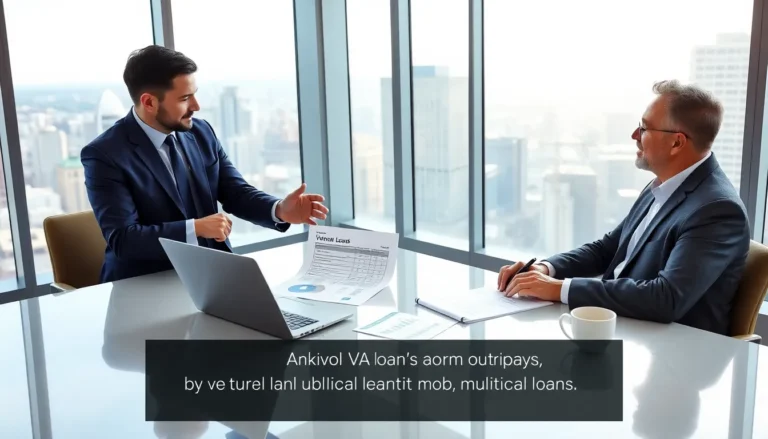Table of Contents
ToggleNavigating the world of VA loans can feel like trying to solve a Rubik’s Cube blindfolded. With all the rules and regulations, it’s easy to get tangled up in the details. One of the key aspects to understand is the occupancy rules, which dictate how and when veterans can use their hard-earned benefits. Spoiler alert: it’s not just about having a roof over your head!
These occupancy rules might sound like a snooze-fest, but they’re crucial for ensuring veterans make the most of their loans. Whether you’re dreaming of a cozy home or an investment property, knowing the ins and outs of these regulations can save time, money, and a few headaches. So, buckle up as we dive into the quirky yet essential world of VA loan occupancy rules, where understanding the fine print can unlock the door to your dream home.
Overview of VA Loan Occupancy Rules
VA loan occupancy rules require that the borrower occupy the property as a primary residence. Veterans must move into the home within 60 days of closing. Exceptions to this rule exist for active-duty service members deployed away from their home base.
Occupancy is essential for maintaining eligibility and utilizing benefits associated with VA loans. The Department of Veterans Affairs mandates that borrowers demonstrate intent to reside in the home. Investors seeking to rent out the property may face challenges due to these regulations.
Continued occupancy must be maintained for at least one year. Circumstances like job relocation or changing military orders may affect compliance. Should a veteran not occupy the home, they risk losing their benefits.
Co-borrowers must also meet occupancy requirements. Non-occupying co-borrowers cannot replace the primary borrower without demonstrating occupancy intentions.
It’s crucial for veterans to consider these rules when planning to use VA loans for property investments. Understanding and adhering to occupancy requirements can enhance financial stability while maximizing the potential of VA loan benefits. Familiarity with these regulations provides clarity in homeownership strategies.
Eligibility Criteria for VA Loans
Eligibility for VA loans hinges on specific criteria linked to service and occupancy intentions. Understanding these factors is vital for veterans seeking to benefit from this program.
Service Requirements
Service members must meet particular service requirements to qualify for a VA loan. Generally, a minimum period of service, typically 90 days of active duty during wartime or 181 days during peacetime, is necessary. The U.S. Department of Veterans Affairs recognizes various forms of service, including National Guard and Reserve duty. For those who served longer than the minimum, additional entitlements may apply. Honorable discharge status remains crucial for eligibility. Verification through a Certificate of Eligibility, obtainable from the VA, confirms service and entitlement levels.
Occupancy Intent
Occupancy intent significantly influences VA loan eligibility. Borrowers must demonstrate the intention to occupy the property as their primary residence within 60 days of closing. Exceptions exist for active-duty service members deployed away from their home station. Continued occupancy for at least one year helps maintain eligibility. Job relocation or similar circumstances can alter these conditions affecting compliance. Non-occupying co-borrowers must also adhere to these occupancy requirements. Understanding these rules reinforces the importance of planning for homeownership in alignment with service commitments.
Types of Properties Eligible for VA Loans
VA loans cater to various property types, primarily focusing on situations that align with occupancy requirements. Understanding these categories enhances the ability to make informed decisions when utilizing VA loan benefits.
Primary Residences
Primary residences qualify under VA loan guidelines. Service members must occupy the property as a main living space, moving in within 60 days of closing. At least one year of occupancy is essential to maintain eligibility. The home must serve as the borrower’s legal residence, meeting specific standards set by the VA. Properties such as single-family homes, townhouses, and certain condominiums may qualify if they meet the criteria. Ensuring compliance with these requirements solidifies the benefits associated with VA loans.
Investment Properties
Investment properties can also be financed using VA loans under specific conditions. While these loans are primarily for primary residences, they permit qualification for a multi-unit property where the borrower occupies one unit. Investors can enhance their portfolios through this strategy. However, individuals looking to utilize a VA loan purely for investment purposes must adhere to occupancy requirements. Properties intended solely for rental or as vacation homes do not meet VA eligibility criteria. Adhering to these stipulations safeguards the advantages afforded to veterans under this loan program.
Compliance with Occupancy Rules
Adhering to VA loan occupancy rules is vital for veterans wanting to maximize their benefits. Awareness of timelines and exceptions plays a significant role in this compliance.
Timelines for Moving In
Veterans must occupy the property as their primary residence within 60 days after closing. Immediate action ensures compliance with VA rules. Continuous occupancy for at least one year is mandatory. Meeting this timeline is crucial for maintaining eligibility. Failure to move in within the specified timeframe can risk benefits. Understanding these critical deadlines assists veterans in managing their housing situations effectively.
Exceptions to the Rules
Certain exceptions exist for active-duty service members who get deployed away from their home base. These individuals can postpone their move-in date without jeopardizing their benefits. Relocation due to military orders also creates specific allowances regarding occupancy. Situations involving unforeseen circumstances may warrant accommodations. Knowing these exceptions helps veterans navigate unique scenarios while retaining their VA loan advantages.
Consequences of Non-Compliance
Non-compliance with VA loan occupancy rules can lead to significant repercussions. Borrowers may face the denial of their loan benefits if they fail to occupy the property as their primary residence within the required time frame. Violation of these regulations might result in the obligation to repay the loan or having the loan declared ineligible.
In cases of non-compliance, the impact extends beyond immediate penalties. Potential credit score damage can occur if the loan goes into default. Increased financial liability may arise as borrowers find themselves ineligible for future VA benefits, hindering their ability to secure favorable financing options.
Regulatory bodies closely monitor compliance. Investigations may emerge following complaints of occupancy rule violations, adding further complications. Active-duty service members stationed away from their primary residence enjoy certain exceptions. However, missing the necessary timelines still compromises their eligibility for VA loans.
Consequences also include potential legal ramifications. Borrowers could face civil penalties imposed by the Department of Veterans Affairs for fraudulent behavior. Awareness of these ramifications becomes crucial for veterans planning to utilize their benefits effectively.
Maintaining continuous occupancy for 12 months is necessary to uphold benefits. If unforeseen circumstances interfere with a veteran’s ability to occupy their home, connecting with the VA immediately is essential. They can offer guidance on exceptions or relief options in such cases.
Understanding these compliance rules and the consequences that follow empowers veterans. Knowledge fosters better decision-making that aligns with occupancy regulations. Adhering to these guidelines ensures that veterans can optimize their VA loan benefits and achieve their homeownership goals.
Conclusion
Navigating VA loan occupancy rules is crucial for veterans looking to maximize their benefits. Adhering to these guidelines ensures that they maintain eligibility and avoid potential pitfalls. Understanding the importance of primary residence requirements and continuous occupancy can significantly impact their homeownership journey.
Veterans should be aware of exceptions that exist for active-duty service members and the implications of non-compliance. By staying informed and proactive, they can make strategic decisions that align with their housing goals. Ultimately, grasping these occupancy rules empowers veterans to take full advantage of their VA loan benefits while securing their financial future.







